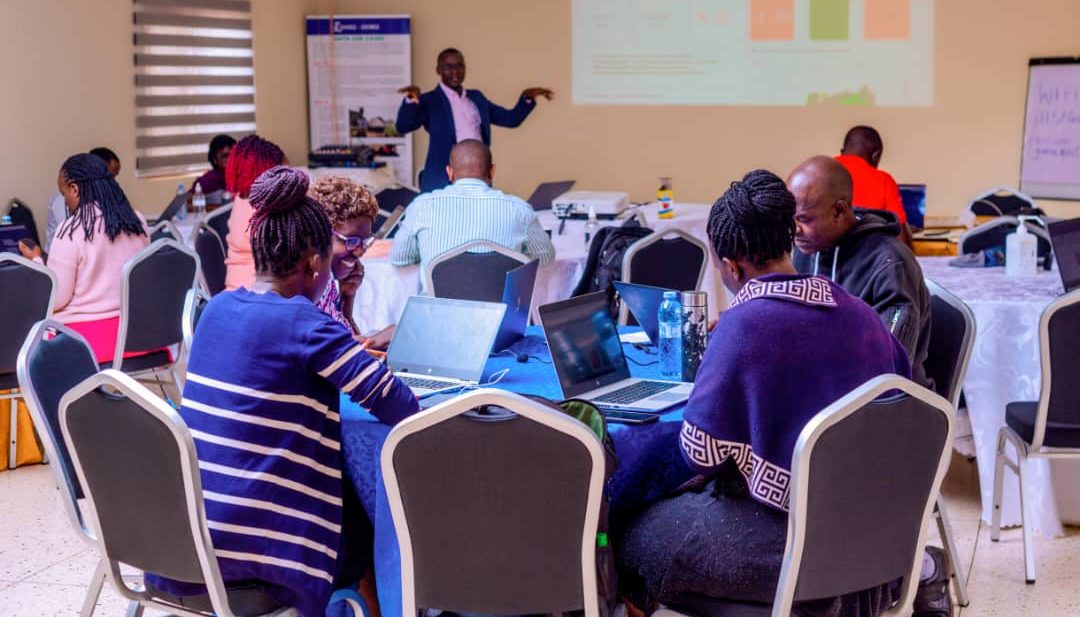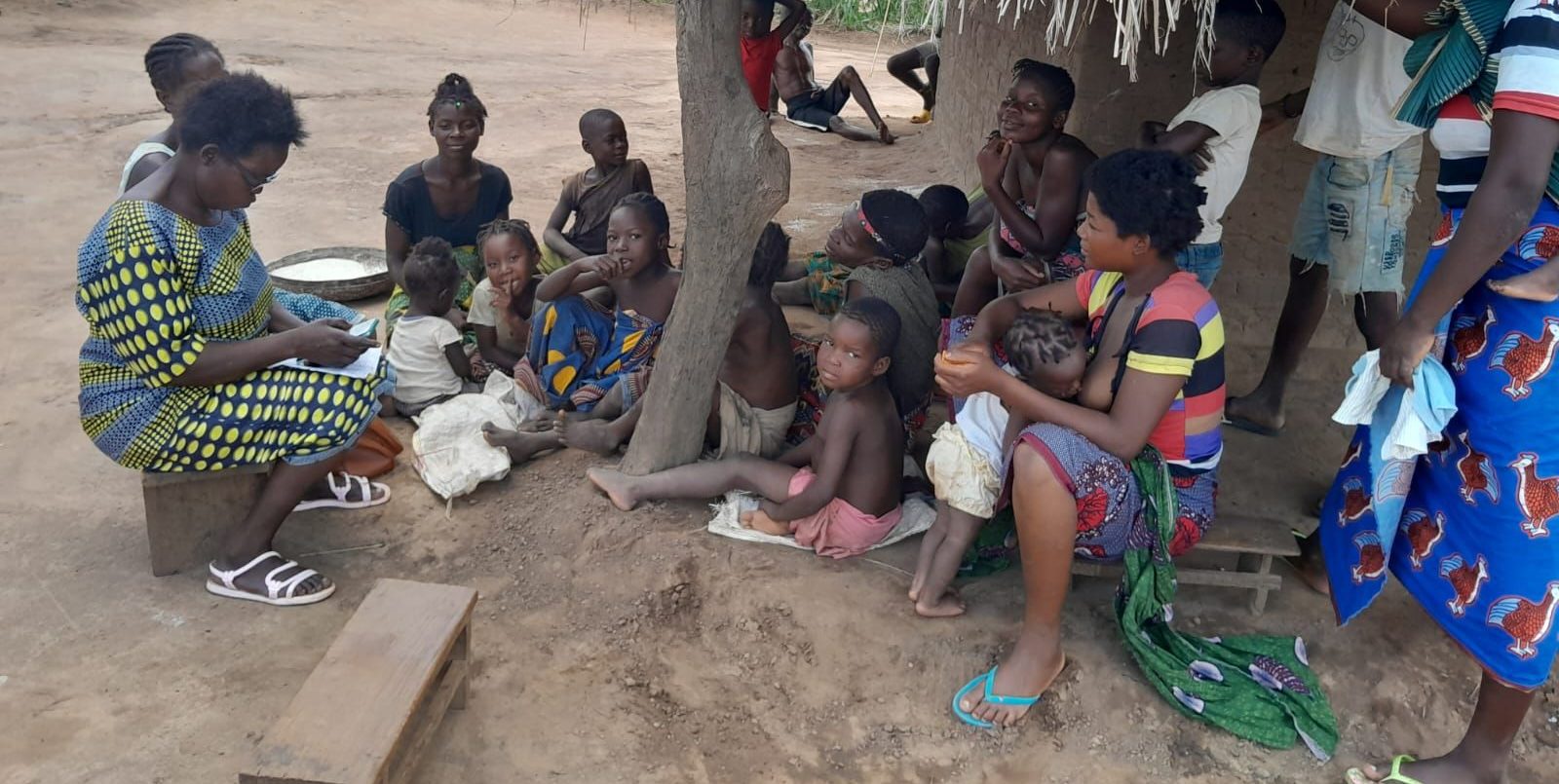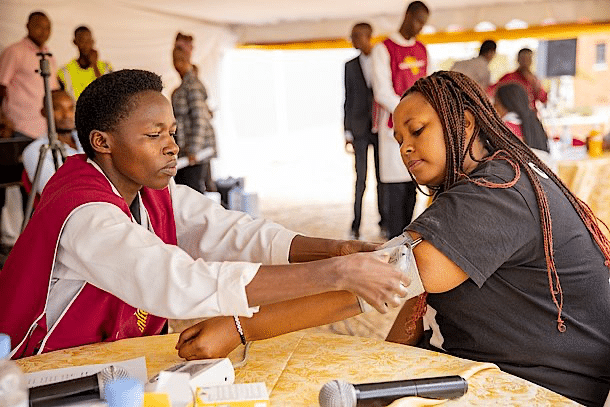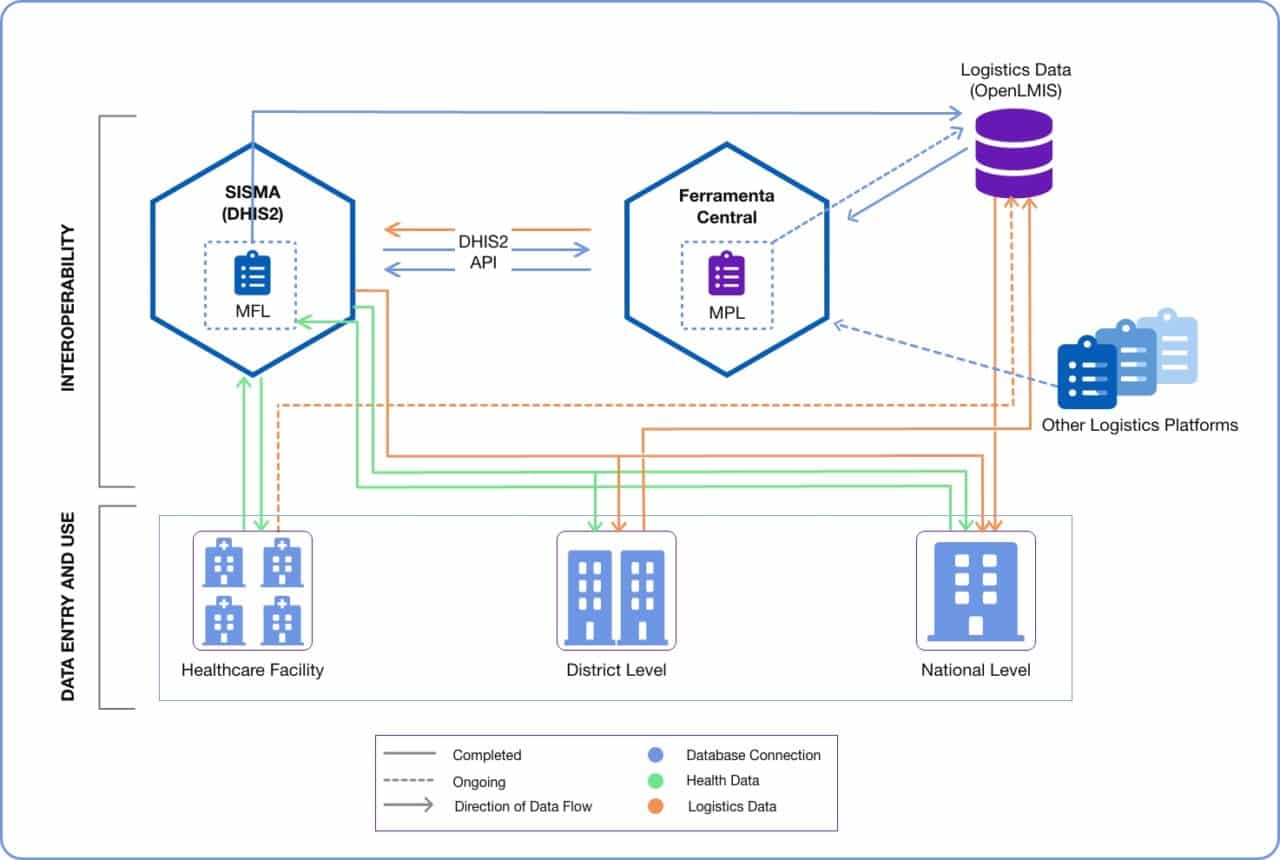
Harnessing the interoperability capabilities of DHIS2 to deliver life-saving logistics systems in Mozambique
Donor agencies and implementing partners support the government of Mozambique to strengthen the country’s health logistics by interconnecting DHIS2 and other systems for electronic supply chain management
Over the past several decades, significant progress has been made in the quest to resolve some of the challenges that plague healthcare in Africa. According to data from the WHO, infant mortality in the region has continually declined over the past 20 years, from about 80 per 1000 live births in 2000, to 40 per 1000 in 2020. Likewise, life expectancy for the same period has risen from 53 years to 64 years. Despite these gains, Africa still bears a disproportionately higher disease burden than the rest of the world. Neonatal conditions and vaccine-preventable infectious diseases still constitute the greater health burdens for most countries in the region. This is attributable, among other factors, to inadequate healthcare logistics systems, which make it difficult to ensure that vaccines, treatments and medical supplies reach the populations that need them.
In Mozambique, some health facilities are reporting immunization coverage of greater than 100% even when the vaccine stock for the facility is still not exhausted. Also, some facilities have excess stock of vaccines than they require, while others do not have enough to meet their demands due to ineffectual logistics decision mechanisms. Strengthening supply chain systems by leveraging modern technologies including DHIS2, would tackle these problems and facilitate equitable access to vaccines, medicines and commodities.
In response to these challenges, the Mozambican Ministry of Health (MISAU) partnered with organizations such as Global Fund, USAID, GAVI and Saudigitus (HISP Mozambique) to implement innovative electronic solutions for supply chain management by integrating DHIS2 with other data sources and tools. These include OpenLMIS, which was implemented for vaccination-specific stock management as part of the EPI program, the Master Facility List (MFL) which is a part of the DHIS2-based HMIS (SISMA), and the Master Product List (MPL) built into a custom platform called Ferramenta Central (FC). The resulting interconnected health logistics systems are tailored to the local environment to facilitate effective healthcare logistics management by providing reliable stock management data for drugs, vaccines and other medical commodities, as well as analyzing health and logistics data for better reporting and planning. In achieving this, Saudigitus leveraged the interoperability capabilities of DHIS2, as well as their experience in developing the SISMA interoperability layer, to expand the national HMIS platform, integrating logistics data from MISAU and those held in FC.
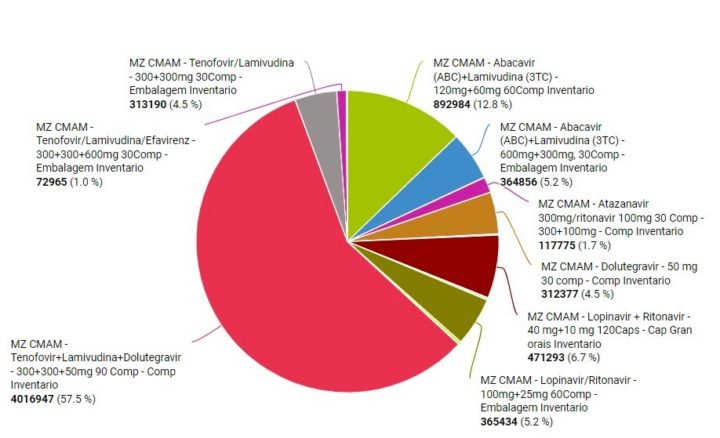
The Evolving Healthcare Supply Chain Structures in Mozambique
Logistics systems for healthcare are intricate chains of processes by which medicines and medical consumables are delivered from their manufacturers to the health facilities where they are required. To be effective, these systems must be well coordinated to ensure that temperature-sensitive commodities are stored in controlled environments throughout the chain and that all supplies are delivered in good time to avoid stock-outs or expiration.
Mozambique is a large country in southeastern Africa, spanning 309,500 square miles, and home to about 30 million people. With limited transportation and storage infrastructure, the country’s healthcare has been hampered by ineffective supply chain systems for drugs, vaccines and medical consumables, especially last-mile delivery to health facilities in remote locations. Prior to 2014, all healthcare commodities meant for the country’s public healthcare facilities were stored in three Central Medical Stores (CMAM). This posed significant logistical challenges while delivering drugs to remote health facilities in the face of limited transportation infrastructure, especially when the need arose for life-saving medicines and consumables to be delivered urgently. Consequently, the need to build decentralized supply-chain systems for the country became essential to mitigate these challenges.
In 2013, the government of Mozambique developed a Health Sector Strategic Plan 2014-2019, a policy document that would guide MISAU to implement measures for improving the National Health System (NHS) by addressing identified gaps. Among other measures to be taken, the policy document identified the need to decentralize the healthcare supply chain and adopt modern technologies to streamline them. In partnership with USAID, UNDP, GAVI and other donor agencies the government of Mozambique has, since 2014, constructed regional warehouses to bring the supply chain closer to healthcare facilities throughout the country. Supplies from these warehouses are requisitioned at the district level, and further distributed to the districts on a quarterly basis. To further improve Mozambique’s supply chain management, DHIS2, FC, OpenLMIS and other software systems have been adopted to enhance the function of the country’s public health logistics system through digitization, interoperability and real-time reporting.
The impressive strides made by MISAU since 2014 to improve the healthcare supply chain in Mozambique have been facilitated by good collaboration with partners including Chemonics and VillageReach. These partners, funded by USAID and Gavi respectively, have worked with the government of Mozambique at different levels, to strengthen CMAM by enhancing procurement management, stock tracking and accurate reporting. Both implementing partners also collaborate with Saudigitus to expand the SISMA interoperability layer through API integrations.
Strengthening distributed supply chain management through integration
Starting in 2015, USAID, through the Global Health Supply Chain – Procurement and Supply Management (GHSC-PSM) project, supported CMAM, the Provincial Health Directorates (DPS) and the Central Department of Laboratory (DCL) to improve logistics and supply chain systems, with the view to ensuring regular availability of high-quality and low-cost medicines and commodities in health facilities. To achieve this objective, USAID engaged Chemonics to interconnect DHIS2 with existing and new logistics platforms and data sources. Consequently, Chemonics developed a custom platform called Ferramenta Central (FC), a higher-level data repository and integration tool used to collate and store cross-platform logistics information relating to various health programs including HIV, TB, malaria and nutrition in Mozambique.
Before FC was implemented, databases for commodities tracking were disjointed and without standardized procedures for data quality validation. Using the FC, data is now imported directly from any of the various databases that hold logistics data for the different health programs and is reproduced in other systems. During this process, the FC performs data quality evaluations to detect inconsistencies or abnormalities that can be rectified in the source database before the data is shared with other systems. Since its adoption, FC has facilitated an increase in the rate of requisition, thereby improving data collection used in forecasting and supply chain planning. The FC has also reduced the average amount of time required to prepare a distribution plan for drugs, vaccines and consumables from 15 days to about 5 minutes.
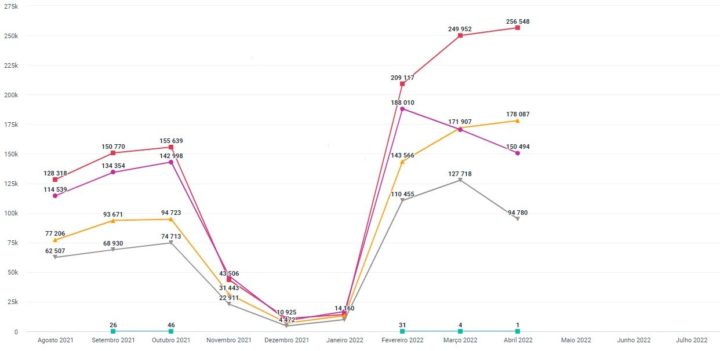
The MFL is a comprehensive list of all health facilities in Mozambique built into the HMIS based on the DHIS2 organizational unit structure. It contains updated metadata of all the health facilities such as location, category and date of establishment, among other information which is used to inform logistical decisions. Development of the MFL was supported by Global Fund, through Saudigitus, to facilitate data exchange between DHIS2 and other platforms via the DHIS2 API. So far, linking the MFL with FC is complete and is relied upon for essential data in managing the logistics component of the CMAM up to the facility level. Likewise, the MFL has been utilized to interconnect the SISMA with the Civil Registration and Vital Statistics (CRVS) platform.
Similarly, Chemonics developed the Master Product List (MPL), which contains details of all medicines, vaccines and consumables available in the various warehouses. The MPL is hosted within the FC platform and accessed by OpenLMIS to determine stock availability and levels. With this solution, supply chain managers are able to monitor changes to stock data for specific programs or the NHS at different organizational levels using triangulated data from the MPL, MFL and OpenLMIS in FC. In the near future, there is a plan to integrate the MPL, MFL and a Human Resource system within SISMA. When complete, this would allow for linking available logistics, staff and facility data in one DHIS2-based platform for efficient planning.
Operational mechanisms of the integrated supply chain system
Ferramenta Central sits at the center of the integrated supply chain system by facilitating data exchange among platforms and tools that make up the system. When a commodity is added to FC, the record of that commodity is pushed to the MPL and the relevant HMIS unit within MISAU is notified of a pending change in stock levels via an application that serves as a monitoring system within the SISMA interoperability layer. After the entry is reviewed, the commodity is added to the appropriate group in the MPL, making it accessible to the correct program or health facility as indicated in the MFL. Aggregate data from this integrated system, such as the number of patients, drugs and commodities provided is made available in DHIS2, which serves as the data repository and HMIS. This aids logistics planning at the national and sub-national levels, supporting efforts for the long-term availability of medicines and commodities in health facilities.
Immunization logistics data is pulled from OpenLMIS implemented for commodity and drug stock tracking and inventory in CMAM. This is through an initiative of Gavi which funded the implementation of OpenLMIS for EPI data management in Mozambique. The EPI OpenLMIS system, known in Mozambique as Sistema Electronico de Logistica de Vacinas (SELV), is set up by VillageReach for vaccine distribution planning. Using the SELV, stock data is entered in OpenLMIS and subsequently mapped to the MFL in DHIS2, validated by FC and transferred to the repository via the DHIS2 API thereby making essential immunization data readily available at the national level.
Also, Saudigitus is currently working with VillageReach to develop a Tracker-based Electronic Immunization Register for all routine vaccination. When complete, this will easily be integrated into the existing Tracker system used to record the ongoing COVID-19 vaccination mass campaign. This initiative is in line with Mozambique’s plan to transition current COVID-19 vaccination efforts from a mass campaign to routine immunization and will culminate in the creation of a unified immunization registry for the country that is readily interoperable with the HMIS and other program platforms for better analytics. Having vaccine stock data in DHIS2 would also help facilitate more effective management of routine immunization programs by leveraging its capabilities for generating on-demand detailed reporting.
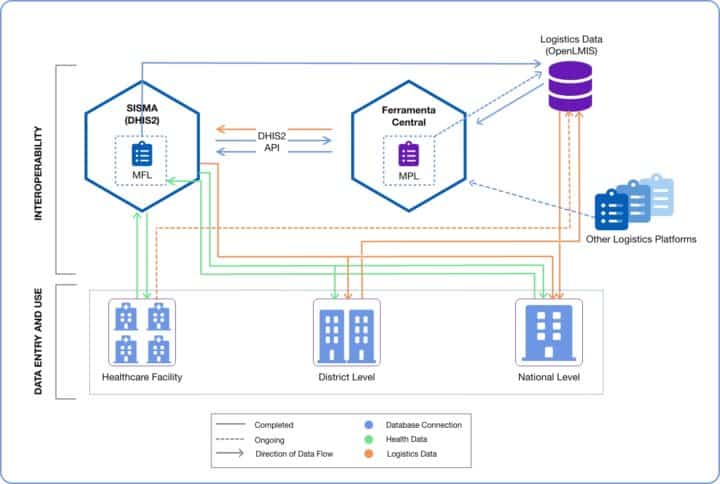
Current limitations and challenges
At the moment, logistics planning based on FC is not in real time because data collected at lower levels are reviewed at the central level before supply decisions are made. Furthermore, data validation and cleaning processes take 1-2 months. As commodities are provided to facilities on a quarterly basis, this collection and processing tempo does not itself present a logistics issue under the current distribution model, though it does result in delays in the generation of accurate monthly reports.
Other constraints of the OpenLMIS-DHIS2 integration include the lack of an electronic data capture system for OpenLMIS at the facility level and the non-availability of analytical data at the district and facility levels. The latter issue is being resolved in the ongoing efforts to update the MFL and expedite the cleaning and validation processes for the data in OpenLMIS. For the former, Saudigitus and their partners are evaluating multiple solutions to allow for facility-level stock data capture, including the use of DHIS2 as an end-user LMIS through which facility-level health workers can capture basic stock data with the DHIS2 Android app, using the same mobile devices already in use for collecting health program data into DHIS2. Pending the resolution of this issue, Mozambique is still using SMT, a Unicef-supported Excel-based stock management tool, in parallel to OpenLMIS to collect and analyze stock data.
Future plans for an efficient healthcare supply chain in Mozambique leveraging DHIS2.
Though the integrated health logistics system is still in development and the pace has been affected by the COVID-19 outbreak, significant benefits to the health system in Mozambique have been achieved. Easier tracking of stock level data for medicines and commodities; connecting logistics data to the MFL, and easier reporting of essential logistical data to MISAU and funding partners have significantly improved.
Saudigitus continues to work with the government of Mozambique, donors and implementing partners on the planning and implementing of further enhancements to the national health logistics system, including supporting the use of commodity data in DHIS2 by the Malaria, TB, HIV and nutrition teams, and developing a DHIS2-based Electronic Immunization Registry, which – when integrated with the supply chain system – will help MISAU monitor and manage routine immunization programs more effectively.
